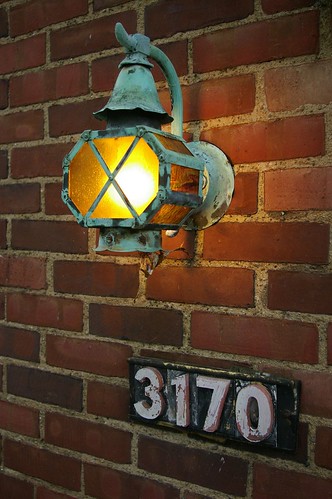
One of the most interesting, most impressive houses that we saw during our search was this one, at 3170 Ludlow, in Shaker Heights, Ohio.
On the exterior, it appeared like an ordinary late 1920s brick Tudor Revival style home. There were aluminum awnings over the windows, which have since been removed, and shrubs that took up a bit too much of the yard. The price was about right, and it looked interesting, so we thought we'd take a look.
The layout of the interior was what we might expect for a house of this vintage in this area, but the way it was finished, oh!

The kitchen was tiled in yellow with green accents. The massive hood, built for the original gas range remained. There are some who will express a strong dislike for the wallpaper. I agree. Wallpaper, one must remember, can be changed easily ehough without affecting the fabric of the house.
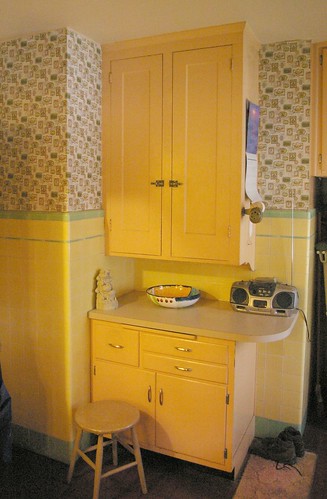
The tile continued around the kitchen. The top cabinet shown here is original, while the bottom one is a later replacement, in the original location. The tile continued to the right, into the icebox nook.
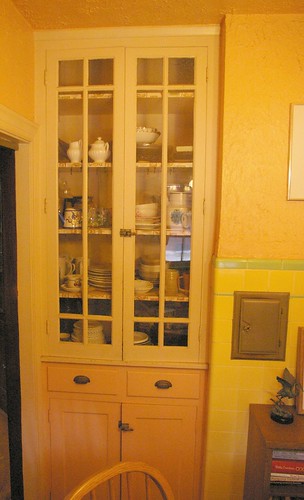
The breakfast nook, which featured this nice built-in cabinet, was also tiled.
The rest of the first floor was much as we had expected. The dining room included two nice built-in cabinets with leaded glass in their doors. The stairs to the second floor featured a simple, almost art deco wrought iron railing.
One especially nice feature I noticed on the first floor, which continued throughout the house, involved the windows. The windows were wood casements, meaning that they swing out rather than sliding up and down. Screens and storm windows are usually mounted on the inside. As a result, you have to remove the screens to open or close the windows. This was not the case with this house. Each screen had a small hole at the bottom through which a crank could be fit. With the crank in place, you could open or close the window without having to undo the various bits of hardware holding the screen in place.
Then I saw the first floor bathroom.
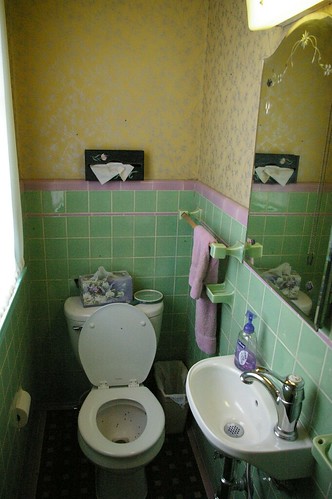
The bathroom features purple and green tile. Even the floor has purple and green tile. While not original, the current sink fits into the space nicely. I haven't seen a 1920s sink that would work as well as this one does in a bathroom this size.
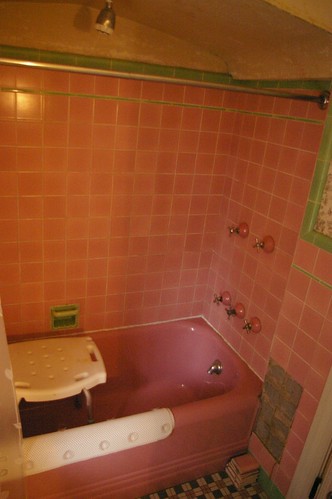
On the second floor, it got even better. Both bathrooms were tiled in pink and green. Even the tub in one bathroom was pink!
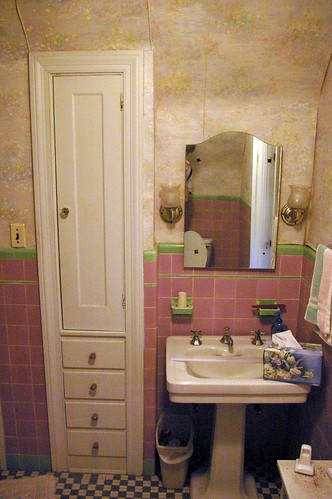
While one of the sinks and both of the toilets on the second floor were replaced, I doubt that they too were pink originally. This sink is period-correct and likely original. As it is white, it suggests that the other sink and toilets were originally white, too. Pink toilets and sinks were available, as were many other colors.
The colors of the tile would stand out even more if the wallpaper was removed and the walls painted a good color. I'm not sure what that color would be. My inclination is white, but I'm inclined to paint everything white, so take that for what you will.
I hope that this helps illustrate that 1920s and 1930s bathrooms color choices were not limited to white, white, and white. The dominance of white as the bathroom color of choice ended in the early 1920s. A wide variety of colors became available, both with regard to tile as well as fixtures. Even massive drainboard sinks were available in a variety of colors (here's one example), though white remained most popular.
I admit that these colors aren't for everyone. If you have a bathroom or kitchen like this, I strongly encourage you to retain it. Colored bathroom fixtures are hard to find and tend to be very expensive when they do show up. If you're going to get rid of them, please let me know and I'll offer them up to the readers - I'm sure there will be many people eager to give them a good home.




COLOR was the name of the game in the 1920s through the 1950s in bathrooms. Ceramic tile - a great deal of it produced in Ohio was inexpensive and the latest in a sanitary wall finish. The original kitchen cupboards and narrow countertops are also very in step with the time as most wives still used a work table in the main kitchens. And making the table a 100% working surface is part of the reason why tiny built in breakfest nooks became all the rage in the 1950s (much like the single depth snack counter was the rage of the 1950s) because it segregated the breakfest and lunch meals into a small, easy to clean to area.
ReplyDeleteHow times change. Today the kitchen is not small to promote efficiency. New build houses have kitchens that are double, even triple the size of a 1920s kitchen. Whereas in the 1920s the idea was to compartmentalize the task of cooking, now we long to show it off and make the kitchen, and not the living room, the centerplace of the family home. The irony is, that the "living room", an invention of the 1900s, is now anything but since people don't use them living, but rather as a showplace of unused space.
WOW, we have that same exact tub and sink in the last 2 pictures!
ReplyDeleteThank you for sharing this house tour! I really think it's important to maintain the original character of a home. I especially love old tiled bathrooms. It is such a shame when home owners tear out this colorful tiled bathrooms. Save the pink bathrooms! My home has a vintage black and purple tiled bathroom which I recently posted about here: http://thetinytudor.blogspot.com/2010/09/powder-room-or-crazy-purple-black.html
ReplyDeletei owned 2903 ludlow, it was the hallie(hallie building) familys first house. it had the same style bathroom with pink tiles on 1 side of the house. 3 full bathrooms, 1 on each floor for a total of 6 full bathrooms in the whole house.
ReplyDelete